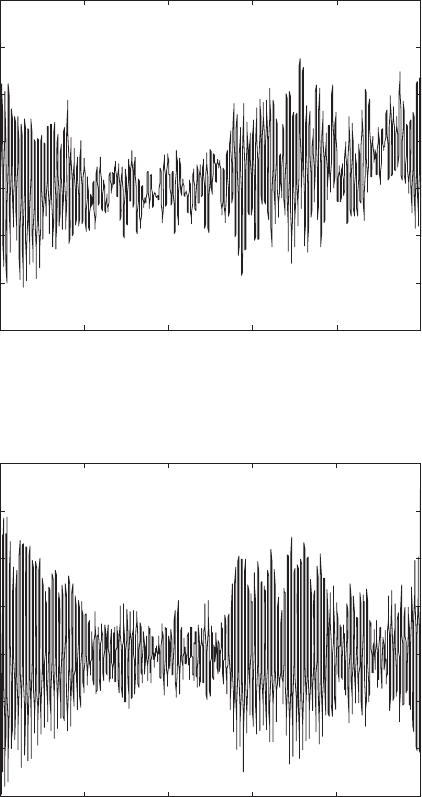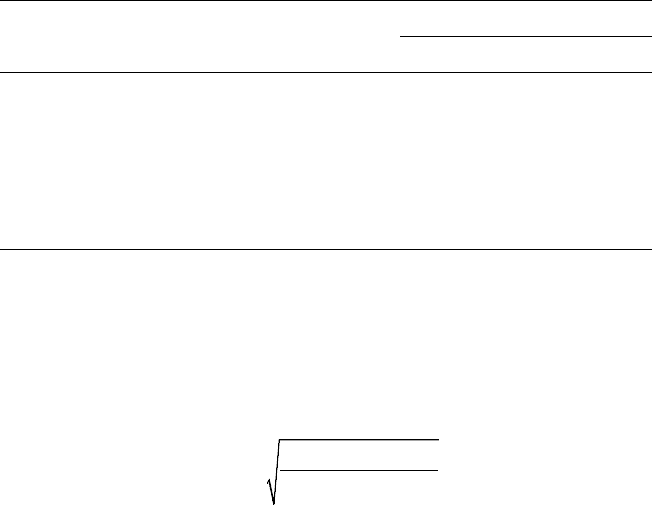Tong W. Wind Power Generation and Wind Turbine Design
Подождите немного. Документ загружается.


Tower Design and Analysis 535
the blades masses are lumped on the top of the tower thus, ignoring the tower–blade
interaction. The maximum observed tower tip response is 0.108 m.
The forced vibration response of the coupled tower–blade model is also calcu-
lated for a rotational frequency of 1.57 rad/s. Figure 4 presents a Fourier transform
of the simulated fl uctuating wind velocity acting at the tip of the blade. An increase
in energy is clearly observable at integer products of the rotational frequency.
Figure 5 illustrates the computed blade tip displacement time-history. The maxi-
mum observed displacement is approximately 0.75 m. Figure 6 presents the total
0 10 20 30 40 50 60 70 80 90 100
0
0.02
0.04
0.06
0.08
0.1
0.12
Time (s)
Total Response (m)
Figure 3: Displacement time-history at the top of the tower ignoring blade rotation.
0 5 10 15 20
10
0
10
1
10
2
10
3
10
4
Frequency (rads
-1
)
Fourier Amplitude
Figure 4 : Fourier transform amplitude of wind velocity.

536 Wind Power Generation and Wind Turbine Design
base shear time-history due to the forced vibration of the three rotating blades.
A maximum base shear force of nearly 150 kN is observed. The three rotating
blades are now coupled to the tower-nacelle and the maximum tower tip displace-
ment response is found to be 0.385 m, as presented in the displacement time-
history in Fig. 7 . Thus, inclusion of blade–tower interaction results in a 256%
increase in peak tip displacement of the tower compared to the case excluding
blade–tower interaction.
0 20 40 60 80 100
-0.4
-0.2
0
0.2
0.4
0.6
0.8
1
Time (s)
Total Response (m)
Figure 5: Blade tip displacement time-history.
0 20 40 60 80 100
-1.5
-1
-0.5
0
0.5
1
1.5
2
x 10
5
Time (s)
Total Base Shear (N)
Figure 6: Base shear time-history.

Tower Design and Analysis 537
In the approach by Murtagh et al. [ 30 ], the coupled system equation of motion
is primarily cast in the frequency domain via Fourier transform. This allows the
coupling of the tower and the blades. The time domain along-wind response of the
coupled assembly is ultimately obtained by inverse Fourier transform. There are a
number of merits behind this type of approach. The technique is relatively simple,
especially compared with a more computationally expensive fi nite element formu-
lation. The approach may be used in a preliminary quantitative design, which may
subsequently be validated by a more rigorous analysis. The dynamic properties of
the coupled system are available using the dynamic properties of each of the two
sub-systems, which is an extension of the substructure synthesis approach.
3 Design of tower
A complete dynamic analysis of the tower taking into account the effect of the rota-
tion of the blades (rotors) and the nacelle mounted at the top is necessary for ensuring
the safety and operational serviceability. However, such a detailed dynamic analysis
may be time consuming and rigorous at a preliminary design stage when the initial
confi guration has to be chosen based on the design forces and displacements. Hence,
for an initial assessment it may be more attractive to use an approximate simplifi ed
approach while taking account of the stochasticity in the wind loading (and hence in
the response of the tower) and the rotor–tower interaction.
Gust response factor (GRF) approach is a simple technique used by struc-
tural engineers in the along-wind design of fl exible structures and incorporates
the stochastic and dynamic effects. This technique is now well developed due
to the contributions of Davenport [ 38 ] and Velozzi and Cohen [ 39 ]. GRF is the
ratio of the maximum or peak response quantity to the mean response quantity.
0 10 20 30 40 50 60 70 80 90 100
-0.3
-0.2
-0.1
0
0.1
0.2
0.3
0.4
Time (s)
Total Response (m)
Figure 7 : Displacement time-history at the top of the tower with blade interaction.

538 Wind Power Generation and Wind Turbine Design
Hence, when this factor is applied to the responses from the mean wind loading,
it yields the maximum design values.
The methodology developed by Davenport and, Velozzi and Cohen calculated
the GRF using a ratio of displacements, and while this yielded accurate maximum
expected response for displacement, it was found to fall short in providing esti-
mates of other response parameters, such as bending moment and shear force.
Following the work by [ 38 , 39 ] several new models of the GRF have been pro-
posed by Holmes [ 40 ] and Zhou and Kareem [ 41 ], with the latter being based on
base bending moment, rather than displacement. The GRF methodology has also
become the basis of most modern design codes worldwide [ 42 ].
3.1 Gust factor approach
The traditional Davenport-type GRF assumes that the fl exible structure may be rep-
resented by a single degree-of-freedom (SDOF) representing the fundamental mode
of vibration, and this is usually suffi cient. However, if a structural system like a
wind turbine tower (with coupled tower–rotor interaction) has more than one mode
contributing to the response, the traditional GRF methodology may yield inaccurate
representations of the energy contained in the response. Thus an extension of the
traditional GRF methodology to include the effects of higher modes in the derivation
of the GRF is required for application in the case of a wind turbine tower.
A GRF for evaluating the along-wind response of wind turbine towers has been
proposed by Murtagh et al. [ 43 ]. The approach presented differs from the conven-
tional GRF methods as the GRF contains contributions from two resonant modes,
mainly due to rotor blade–tower interaction effects. The wind turbine tower model
considered contains two inter-connected fl exible sub-systems, representing the
tower and a three-bladed rotor system. It is assumed that all the blades vibrate
identically in the fl apwise mode (out-of-plane) coupled with the tower. Each com-
ponent is initially modelled as a separate degree-of-freedom (DOF) and these are
coupled together to form an equivalent reduced order model of the coupled tower–
rotor system considering the fi rst two dominant modes. Thus, the resonant compo-
nent of the response contains energy output from the two modes of the coupled
system. This is an approximate way to account for the effect of the blades fed back
to the tower including the coupled tower–blade interaction. The GRF is obtained
for both tower tip displacement and base bending moment through numerical
integration, with a closed form expression included for the former.
3.2 Displacement GRF
The displacement GRF [ 43 ], G
DISP
, is obtained as a ratio of the expected maxi-
mum displacement response, X
MAX
( t ) divided by the mean displacement, x , with
the latter being represented by the equation:
CS,1-TT D,1 CS,2-TT D,2
CS,1 CS,2
=+
ff
x
KK
ΦΦ
(10 )

Tower Design and Analysis 539
with Φ
cs, j –TT
( j = 1, 2) being the j th coupled system (CS) mode shape component
at the top of the tower,
CS, j
K is the j th modal stiffness of the coupled system and
D, j
f
is the j th modal mean drag force. Because modal/generalized quantities are
used in eqn ( 10 ), it is assumed that the free vibration parameters obtained from the
tower–rotor system are from a classically damped one. The modal mean drag force
on a structure (i.e. the tower or the blade) is obtained as
2
D, D CS,
0
1
() ()() ()d
2
H
jj
fCzBzvzzzr
⎛⎞
=Φ
⎜⎟
⎝⎠
∫
(11 )
where H is the length over which drag is to be calculated (i.e. the total height of the
tower or the length of the blade), C
D
( z ) is the drag coeffi cient, B ( z ) is the width of
the tower (or blades), and ()vz is the mean wind velocity and Φ
CS,j
( z ) is the j th
mode shape component of the coupled system, all as a function of the spatial vari-
able z . The expected maximum displacement may be obtained as the product of a
peak factor, Ψ (using fi rst passage analysis, as in [ 44 ]) and the root mean square
(RMS) of the displacement response at the top of the tower, s
X
. This RMS dis-
placement response, which includes a second mode of vibration, may be obtained
by taking the square root of the area under the displacement response PSD func-
tion, S
XX
( f ) The PSD function S
XX
( f ) is found as the sum of the products of the
modal wind drag force PSD functions with their appropriate squared amplitude of
the modal mechanical admittance functions [ 43 ].
The modal drag force PSD function may be obtained from the expression:
2
MF MF VV D 1 D 2 1 2 1 2
00
CS, 1 CS, 2 1 2 1 2
() () () ()()()()()
() ()(, ;)dd
HH
jj
jj
S f S f CzCzBzBzvzvz
zzRzzfzz
r=
∫∫
FF
(12)
where S
VV
( f ) denotes the wind velocity PSD function at the top of the tower [ 37 ],
r is the density of air, and R ( z
1
, z
2
; f ) is the spatial coherence function between
elevations z
1
and z
2
[ 19 ]. The mechanical admittance function at the top of the
tower due to a unit force at that point for the j th mode may be obtained as
CS, TT CS,
D,
22 2
CS, CS, CS, CS, CS,
()
4 1 (/ ) 2 (/ )
jj
j
jj j j j
F
Hf
fM ff i ffx
−
=
⎡⎤
−+
⎣⎦
F
p
(13 )
where F
CS, j
is the j th modal force due to a unit force placed at the top of
the tower, f
CS, j
is the j th natural frequency,
CS, j
M is the j th modal mass
2
CS, 0 CS,
(()()d)
H
jj
Mmzzz=∫ Φ
with m ( z ) as the mass distribution of the structure
and, x
CS. j
is the j th modal damping ratio.
Two procedures have been proposed by Murtagh [ 43 ] based on how the value of
s
X
. may be calculated. It may be computed by numerically evaluating an integral
or it may also be obtained in closed form based on some approximation. For the closed
form calculation, a method of decomposition can be employed, in which it is assumed
that the variance of the displacement response PSD function may be separated into
two components: a background component and a resonant component. Contrary to

540 Wind Power Generation and Wind Turbine Design
the conventional GRF approach, in the proposed methodology [ 43 ], there are two
contributions for the resonant component. The square of the non-
dimensionalized form of background component of the gust factor
2
B
G
can be
expressed as
222 222
CS,1 TT CS,1 CS,2 CS,2 CS,2
2
B MF1MF1 MF2MF2
44 2 2 44 2 2
CS,1 CS,1 CS,2 CS,2
00
()d ()d
16 16
TT
FF
GSffSff
fMx fM x
∞∞
−−
ΦΨ Φ Ψ
=+
ππ
∫∫
( 14 )
The integral in eqn ( 14 ) may be evaluated numerically, or by assuming the
integrand to be a white noise, or from a known value of turbulence intensity.
The resonant component of the gust factor comprises of two non-dimensionalized
terms representing contributions of the fi rst and second modes of vibration,
2
R,1
G
and
2
R,2
G
, respectively. These terms are given by the expressions:
22 2
CS, -TT CS, MF MF CS,
2
R,
33 2 2
CS,j CS,j CS,j
()
=,=1,2
64p f M x x
jjjjjj
j
Sf
Gj
ΦΦ Ψ
(15 )
where Ψ
j
is the peak factor associated with mode ‘ j ’. Thus, the closed form solution
for the displacement GRF, G
DISP-CF
, is obtained as
22 2
DISP CF B R,1 R,2
1GGGG
−
=+ + +
(16 )
where G
B
and G
R, j
represent the background and resonant components of the
displacement GRF, respectively.
3.3 Bending moment GRF
A GRF also has been derived based on the bending moment GRF [ 41 ] at the tower
base, G
BM
by [ 43 ] which is presented for comparison. Similar to the displacement
GRF, G
BM
will contain contributions from two modes of vibration and is obtained
as the ratio of the expected maximum base bending moment, Y
MAX
( t ) (= Ψ s
BM
),
to the mean base bending moment,
2
0D
( 0.5 () ()() d).
H
yCzBzvzzzr∫
The RMS of
the base bending moment, s
BM
, is obtained from the equation:
1/2
2
2
2
BM MF MF D,
1
0
() ()d
jjj j
j
SfHffs
∞
=
⎛⎞
=Γ
⎜⎟
⎝⎠
∑
∫
(17 )
where
j
Γ is given by
2
CS, CS,
0
(2 ) ( ) ( ) d
H
jj j
fmzzzzΓ= π Φ
∫
(18 )
The base bending moment GRF, G
BM
may be obtained as
BM
BM
1G
y
s
=+Ψ
(19 )

Tower Design and Analysis 541
A series of numerical examples are presented from [ 43 ] to investigate the
magnitude of GRFs obtained for the model which allows for blade–tower interac-
tion, and these are compared with GRF values obtained from an equivalent SDOF
model which ignores blade–tower interaction by lumping the mass of the blades in
with that of the nacelle. A tower (steel) of height 50 m with rotor (GFR epoxy)
diameter of 60 m is considered with the details available in [ 43 ]. Four different
rotational frequencies of the rotor blades were considered. As rotational frequency
of the blades increases, the fundamental frequency of the blades also increases,
and this leads to increase in the natural frequencies of the coupled systems.
Tables 1 and 2 show the GRFs obtained for the lumped mass equivalent SDOF
and two DOF tower–blade interaction models for a mean wind velocity of 20 m/s
at the top of the tower. A time of 600 s was used to obtain the GRFs, as used in
Eurocode 1 (CEN 2004) [ 45 ]. Included in these tables are the displacement GRFs
obtained by numerical integration and in closed form, G
DISP-NI
and G
DISP-CF
,
respectively, and the base bending moment GRF obtained using numerical integra-
tion, G
BM-NI
. It may be noted that the second mode affects the background and the
resonant components and changes the response obtained from the classical gust
factor approach.
It is evident from Tables 1 and 2 that the choice of modelling strategy, i.e.
lumped mass SDOF or two DOF blade/tower interaction, has a bearing on the
magnitudes of both the displacement and base bending moment GRFs obtained.
When the blades are stationary ( Ω = 0 rad/s) in the two DOF case, the values of
G
DISP-NI
and G
BM-NI
obtained differ from the SDOF model values of G
DISP-NI
and
G
BM-NI
by over 10 and 8%, respectively. These differences remain nearly constant
until the case of Ω = 3.14 rad/s where they are equal to 5 and 8%, respectively.
The values of G
DISP-NI
and G
DISP-CF
showed a close match in most cases, though
it was observed that when the two modes were closest together ( Ω = 0 rad/s),
Table 1: GRFs for SDOF lumped mass model.
G
DISP-NI
2.275
G
DISP-CF
2.291
G
B
1.019
G
R,1
0.792
G
BM-NI
2.429
Table 2: GRFs for coupled model with blade–tower interaction.
Ω (rad/s)
G
DISP-NI
G
DISP-CF
G
B
G
R,1
G
R,2
G
BM-NI
0.000 2.507 2.356 1.032 0.850 0.268 2.633
0.785 2.509 2.370 1.044 0.837 0.266 2.599
1.570 2.503 2.392 1.070 0.833 0.257 2.506
3.140 2.381 2.327 1.059 0.753 0.170 2.225
542 Wind Power Generation and Wind Turbine Design
G
DISP-CF
yielded a difference of 6% from G
DISP-NI
. The difference in the value
dropped to less than 1% when the modes move further apart at Ω = 3.14 rad/s. It
was also observed from Tables 1 and 2 that the displacement and bending moment
GRFs obtained showed some disagreement, with the values of G
BM-NI
being higher
than those of G
DISP-NI
. The largest disagreements were observed at the single DOF
model and the two DOF model case of Ω = 0 rad/s, where differences of 7 and 5%
were observed.
4 Vibration control of tower
As the wind turbines grow bigger in size and become fl exible with the increase in
rotor diameter, it is not only enough to estimate the design forces and ensure the safety
of the wind turbine. Additionally, it is necessary to control the vibration response of
the fl exible wind turbine tower. It has been observed that wind-induced accelerations
may be the reason for the unavailability of wind turbine with increased downtime and
may cause damage to the acceleration sensitive subcomponents and devices in a wind
turbine [ 46 ]. Hence, it is important to consider structural vibration control strategies
for wind turbine towers for operational reliability of wind turbines.
Vibration control strategies for fl exible and tall structures susceptible to large
wind-induced oscillations in general are becoming increasingly important, partic-
ularly with the current tendency to build higher and lighter. HAWTs are no excep-
tion, having experienced a dramatic increase in scale in the past decade. This is
particularly evident in offshore wind turbines, with rotor diameter measuring over
120 m. As the design approach is based on strength considerations, stiffness does
not increase proportionally with increase in height and these fl exible turbines may
experience large-scale blade and tower deformations having non-linear character-
istics, which may prove detrimental to the functioning of the turbine. Thus, there
is distinct merit in investigating the vibratory control of both wind turbine blades,
e.g. using blade pitch [ 47 , 48 ] and towers [ 49 ], using an external energy damper.
Among the several structural vibration controllers available, tuned mass damper
(TMD) as a passive vibration control device has become popular. It suppresses
vibration by acting as an energy dissipator. Considerable amount of literature now
exists on the use of TMDs for fl exible structures [ 50– 52 ]. Use of a TMD for sup-
pression of vibration in a wind turbine tower including blade–tower interaction has
been studied by Murtagh et al. [ 49 ]. They provided a simple analytical framework
in order to qualitatively investigate the effect of a TMD on the fore-aft response of
a wind turbine tower.
4.1 Response of tower with a TMD
The displacement response of a wind turbine tower including blade–tower interac-
tion and rotationally sampled turbulence acting on the rotor blades, and with an
attached TMD may be expressed as [ 49 ]:
DAMP
TT TTB
[ ]{ ( )}+[ ]{ ( )}+[ ]{ ( )} = { ( )}+{ ( )}+{ ( )}Mxt Cxt Kxt Ft Vt F t
V
(20 )

Tower Design and Analysis 543
where [ M
T
], [ K
T
] and [ C
T
] are the mass, stiffness and damping matrices of the
tower/nacelle, respectively, {()},{()},{()}xt xt xt
are the time-dependent displace-
ment, velocity and acceleration vectors respectively, { F
T
( t )} is the total wind drag
loading acting on the tower,
B
{()}Vt
′
is the effective blade base shear acting at
the top of the tower and { F
DAMP
( t )} is the damping force brought about by the
action of the TMD. Details on how to calculate the effective blade base shear
time-histories and total wind drag loadings may be found in Murtagh et al. [ 30 ].
The response time-histories of the tower can be obtained following a modal
decomposition of the tower response, transforming the set of equations in eqn ( 20 )
in a Fourier domain and subsequently applying an inverse FFT [ 49 ].
4.2 Design of TMD
For designing a TMD two important parameters need to be considered, the damp-
ing ratio and the tuning ratio. For an effi cient performance of a TMD these two
ratios need to be optimized.
A number of approximate and empirical expressions are available for the evalu-
ation of the optimum damping ratio of the TMD. Given below is the simple
expression by Luft [ 51 ] for the optimum damping ratio of the TMD:
,opt
2
D
m
x =
(21 )
where m is the mass ratio of the damper (i.e. mass of the damper to the entire
mass of the assembly). In order to tune the damper, its natural frequency is
obtained as the product of a tuning ratio n , times the natural frequency of the
coupled tower–blades system, i.e.:
D
CS,1
w
n
w
=
(22 )
where w
CS,1
is the fundamental frequency of the coupled tower-rotating blades
assembly. It is possible to derive a closed form expression for the optimum tun-
ing ratio of the TMD attached to a damped structure based on the “fi xed- point”
theory of Den Hartog [ 53 ] which had been proposed for the case of undamped
structural systems subjected to sinusoidal excitation. In the optimal design of a
TMD attached to an undamped structural system subjected to sinusoidal excitation
[ 53 , 54 ], two “fi xed-point” frequencies were obtained at which the transmissibil-
ity of vibration is independent of the damping in the TMD. It was also observed
that the amplitude of the response transfer functions at the two fi xed points was
unequal and had a contrasting effect with the change in the tuning ratio. For a
structure subjected to an external force which has wide banded energy content or
which has dominant energy at the natural period of the structure, the maximum
response reduction is achieved when the area under the transfer function curve
is at a minimum. This implies that the values of the transfer function at the fi xed
points should be equal and the value of the tuning ratio for which this occurs is the

544 Wind Power Generation and Wind Turbine Design
optimal tuning ratio of the TMD. Ghosh and Basu [ 55 ] extended the theory based
on “fi xed-points” to obtain closed form expression for optimal tuning ratio in case
of a damped structure. This was used by Murtagh et al. [ 49 ] designing an optimal
TMD for a wind turbine tower. The expression for the optimal tuning parameter
n
opt
for a wind turbine tower with damping ratio x
n
in the fundamental mode of
vibration is [ 49 , 55 ]:
22
14 (2 1)
opt
3
(1 )
nn
xmx
n
m
−− −
=
+
(23 )
The optimal tuning ratio together with an optimal damping ratio in the TMD will
minimize the maxima of the displacement transfer function of a wind turbine tower.
Murtagh et al. [ 49 ] considered a tower of hub height 60 m and blades with
radius 30 m for a three-bladed wind turbine and designed a TMD for suppression
of the tip displacement. The mean wind speed at the top of the tower was assumed
to be 20 m/s. The fi rst three modal damping ratios of the tower were assumed to be
1% of the critical. A mass ratio of 1% was assumed for the TMD, giving the
damper a damping ratio of 5% of critical. Thus, when used in conjunction with eqn
( 23 ), an optimal tuning ratio of 0.99 is obtained. The forced vibration responses of
the coupled tower–blades model including and excluding the TMD were calcu-
lated and compared. Two rotational frequencies of the rotor system were consid-
ered, and the blades are perturbed under the action of rotationally sampled wind
turbulence [ 30 ]. The design parameters of the dampers designed for the two cases
are presented in Table 3 .
Figure 8 presents the tip displacement transfer function amplitudes obtained for
the coupled tower and rotating blades model ( Ω = 15 rev/min) with and without
the damper. When contrasting the two transfer functions obtained, it is evident that
the presence of the damper causes the peak to split and decrease substantially in
magnitude. Figure 9 presents the simulated wind-induced response of the coupled
blade–tower model, at the top of the tower, including and excluding the damper.
From this fi gure, it is evident that the damper has been effective in suppressing the
vibrations, particularly in the earliest portion of the time-history, where the
Table 3: Properties of the TMD.
Rotational frequency (rev/min)
15 30
Mass ratio (%) 1 1
Tuning ratio 0.99 0.99
Natural frequency (rad/s) 4.45 4.55
Mass (kg) 997 997
Stiffness constant (kN/m) 20.64 19.74
Damping constant (kNs/m) 0.45 0.44
Damping ratio (%) 5 5
